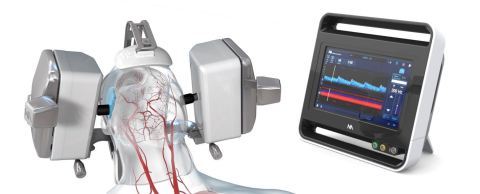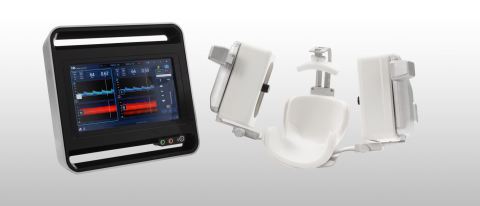LOS ANGELES--(BUSINESS WIRE)--Neural Analytics, Inc., a medical robotics company developing and commercializing technologies to measure and track brain health, announced today that it received FDA 510(k) clearance for its NeuralBot™ System, a robotic assistance technology which automatically adjusts orientation and position of its ultrasound products under the guidance of a healthcare professional. When used with its previously cleared Lucid™ M1 Transcranial Doppler Ultrasound System®, can assist clinicians to non-invasively monitor a patient’s brain blood flow characteristics and can provide information to diagnose a variety of neurological disorders.
“Progress in treating neurological disorders has lagged due to a lack of available low-cost and objective patient diagnostic information. This has resulted in misdiagnosis, treatment delays and additional healthcare expenditures for patients suffering neurological disease,” said Robert Hamilton, Ph.D., Co-Founder and Chief Scientific Officer of Neural Analytics. “Our new technology can assist a healthcare professional- when an expert technician is not available - with the collection of blood flow data to assist clinicians in efficiently triaging patients for appropriate treatment.”
Recently, Neural Analytics presented research data that demonstrated there was no statistical difference between ultrasound blood flow data collected with its NeuralBot™ System or data collected manually by an expert technician with its traditional ultrasound platform.1
“We are committed to advancing brain healthcare through transformative technology that empowers neurologists with the critical information needed to make clinical decisions and improve patient outcomes,” said Leo Petrossian, Ph.D., Co-Founder and Chief Executive Officer of Neural Analytics. “Our products provide clinicians with a cost effective and non-invasive assessment of a patient’s brain health, and can help clinicians diagnose brain disorders, potentially without the need for more invasive testing.”
Each year, neurological diseases cost the U.S. healthcare system nearly $800 billion.2 Traumatic brain injury, migraine, Alzheimer’s and stroke account for more than $438 billion of that cost.2 Stroke affects more than 795,000 people in the U.S. – someone has a stroke every 40 seconds, and someone dies from stroke every 4 minutes.3 It is a time sensitive disease and requires intervention within 24 hours of onset of symptoms.4 Incorrect assessment of large vessel stroke leads to misdiagnosis and treatment delays, resulting in death or disability for stroke patients. Despite recent advances in life-saving treatments for acute ischemic stroke, less than five percent of stroke patients qualify for intervention because they do not present early enough.5 The American Heart Association/American Stroke Association Guidelines for Early Management of Acute Ischemic Stroke state that detection of large vessel occlusion by means of noninvasive intracranial vascular imaging greatly improves the ability to make appropriate clinical decisions.6
Neural Analytics will immediately commercialize the NeuralBot™ System with its currently available Lucid M1 TCD System® in the U.S. as the ‘Lucid Robotic System.’ The Lucid Robotic System, when used for a transcranial doppler ultrasound procedure for patients suspected of neurological disorder, is reimbursable by Medicare/Medicaid and most private payers.
About Neural Analytics, Inc.
Neural Analytics, Inc. is a medical robotics company developing and commercializing technologies to measure and track brain health. The company’s Lucid Robotic System (Lucid™ M1 Transcranial Doppler Ultrasound System® and NeuralBot™ System) is a robotically assisted ultrasound system for brain health assessment. It combines an all-in-one neurovascular ultrasound device, designed to non-invasively measure and display brain blood flow information under the guidance of a healthcare professional. The company’s technology integrates ultrasound, robotics and machine learning to empower neurologists with critical information about brain health to make clinical decisions and improve patient outcomes.
More information is available at http://www.neuralanalytics.com.
1 Fully Automated Transcranial Doppler Ultrasound Insonation
of the MCA using 5 Degree of Freedom Robotically Actuated Probe System,
Presented ESNCH 2018
2 Clifton L. Gooch, Etienne Pracht,
Amy R. Borenstein. The Burden of Neurological Disease in the United
States: A Summary Report and Call to Action. Annals of Neurology,
2017; DOI: 10.1002/ana.24897
3
Center for Disease Control. Stroke Facts. https://www.cdc.gov/stroke/facts.htm.
Accessed April 25, 2018
4 2018 Guidelines for the Early
Management of Patients with Acute Ischemic Stroke: A Guideline for
Healthcare Professionals from the American Heart Association/American
Stroke Association. Stroke 2018;
January 24
5 Christopher R. Bernheisel, MD, Jeffrey D.
Schlaudecker, MD, Katelyn Leopold, MD. Subacute Management of Ischemic
Stroke. American
Family Physician, 2011 Dec 15;84(12):1383-1388
6
Guidelines for the Early Management of Patients with Acute Ischemic
Stroke: A Guideline for Healthcare Professionals from the American Heart
Association/American Stroke Association. Stroke
2013; February 25






